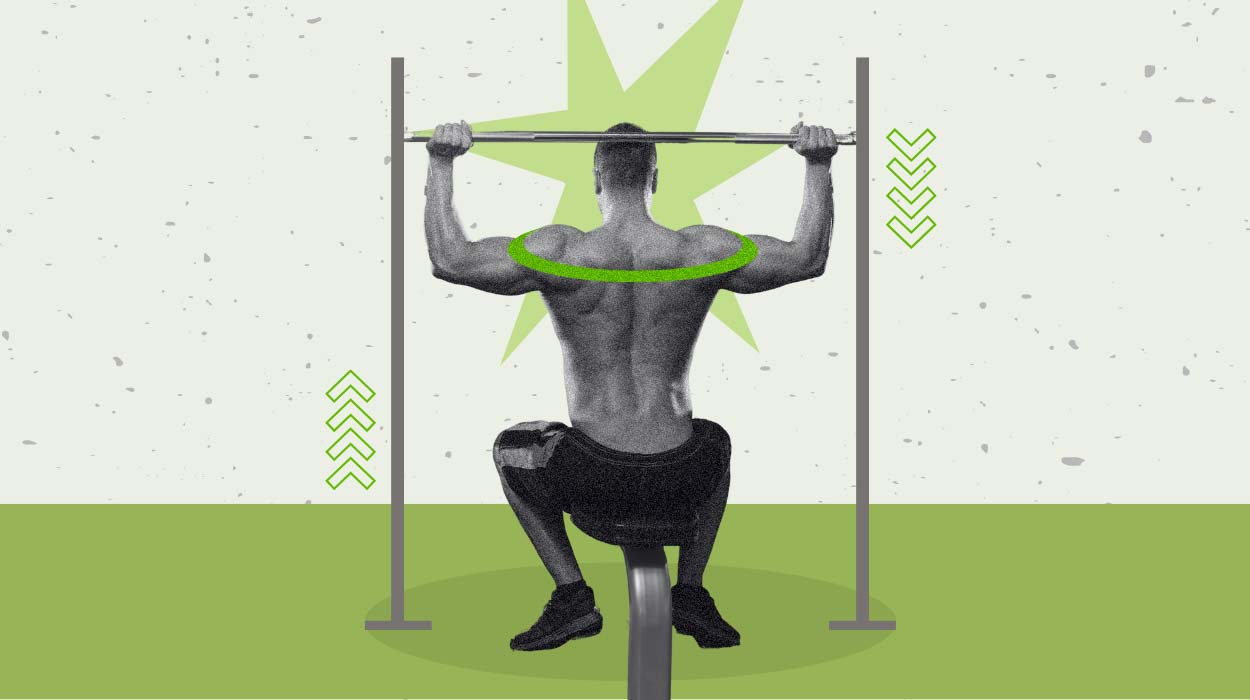
It’s time to focus on the upper body! Whether you want to build an impressive physique, simply build strength, and stability, or relieve pain after an injury, the shoulders are at the center of everything. Focusing on your delts can help you get the definition you’ve been looking for, but you also have an opportunity to improve the overall health of your joints in the process.
The shoulder joint is complex and is involved in many upper body exercises, so building shoulder stability should be a priority along with building muscle mass. This will help you avoid injury as you push your body beyond its current limits.
Let’s take a closer look at some shoulder workouts for men, some of which can be incorporated into a push-day or a five-day workout routine. These exercises will provide the opportunity to build shoulder joint stability and muscle mass.
Seven Shoulder Exercises For Men To Get Bigger Delts
The best exercises to increase deltoid mass and definition will help you target each area of the shoulders [1] while also providing stability and reducing your risk of injury. Some great examples of exercises to include in your workout routine are:
Best Shoulder Workouts For Men In 2024
The shoulder joint is involved in many strength-building exercises for the upper body, especially those focused on the biceps and triceps. Taking a cue from Arnold, many have adopted an approach that combines arm and shoulder workouts so these areas can be tackled together. Shoulder strength and stability can improve your physique and posture and help you avoid injury.
Maintaining proper form in all your exercises is crucial, and working with a registered personal trainer may be helpful. This will help you select exercises that are most likely to help you with your goals and ensure that these exercises will be performed safely to minimize the risk of injury.
Like other target area workouts, it is important to begin with a warm-up and stretches when focusing on the deltoid muscles.
Let’s take a look at some of the best shoulder exercises for men to help you focus on building strength, stability, and muscle mass. These can also help you build a mind-muscle connection and begin to feel those individual muscles working. As your mind-muscle connection improves, you are more able to focus on the contractions of specific muscles and ensure the intended muscles are being recruited.
Standing Overhead Barbell Shoulder Press
An overhead press can be an excellent way to develop strength for individuals with good trunk stability and shoulder range of motion.[2] Your glutes and core must remain engaged to provide stability during this exercise, allowing for core strengthening and shoulder emphasis.
Variations of this exercise allow for an explosive push that engages your arms and chest. You can also utilize the barbell for some exercises that focus more exclusively on your arms as you focus on your upper body. It is important to warm up and stretch before beginning.
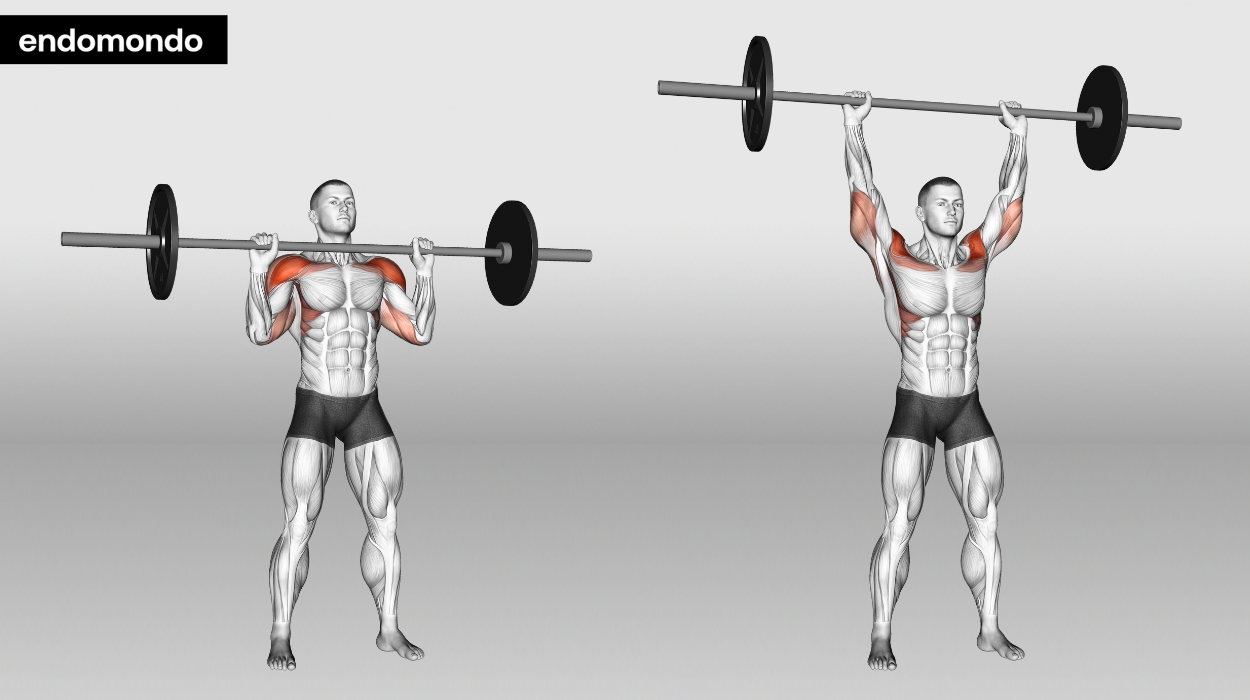
How to do:
- Start in a standing position with your feet shoulder-width apart.
- Engage your glutes and core to steady your back.
- Hold the barbell at upper chest height with your palms facing forward.
- Push the barbell up, allowing for a squeeze at your shoulder blades as the bar reaches its highest point.
- Continue to engage your glutes and core as you lower the bar in a slow, smooth motion. Your back should remain motionless throughout the lift. You may allow a slight bend in the knees.
Tips:
- This exercise requires full body engagement and should be performed early in a workout to prevent lapses in form caused by fatigue.
- Exhale as you push upward and reach maximum height.
- Inhale during the downward movement.
- On the downward movement, keep your core engaged with your knees slightly bent.
- Using a lifting belt can help you keep your back stable.
Optimal Sets & Reps: 3-4 sets of 6-8 reps.
Seated Dumbbell Shoulder Press
By using a seated starting position, you can more effectively target the shoulders because less energy is devoted to keeping your core engaged. This exercise keeps your muscles balanced — separate dumbbells mean no room for one side to compensate for the other. This helps you focus on equal development of both shoulders.
This is an excellent way to target the anterior deltoid, lateral deltoid, and posterior deltoid muscles in addition to some tricep involvement. The core should also remain engaged to prevent your back from arching. This movement requires independent, coordinated control of each dumbbell, and using a spotter may help you avoid back or shoulder injuries.
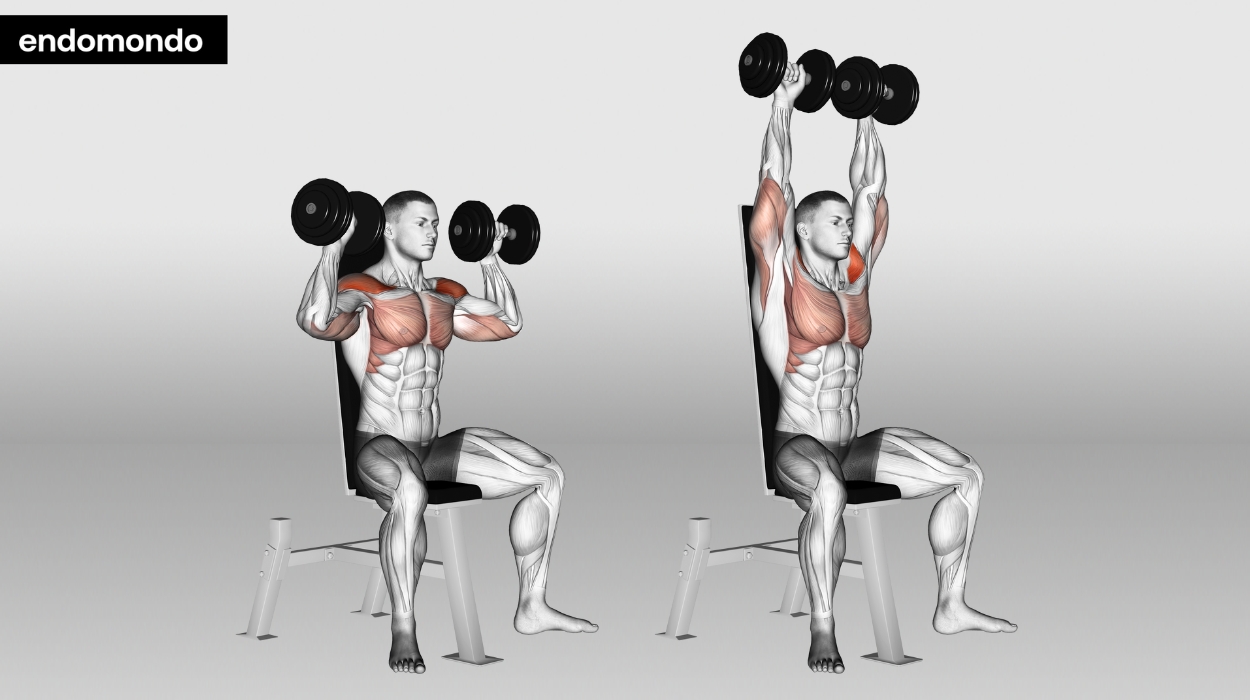
How to do:
- Begin in a seated position using a military bench or similar.
- Hold dumbbells in each hand at shoulder height with your palms facing forward.
- Engage your core to ensure your posture is maintained and your spine remains straight.
- Lift the dumbbells over your head until your arms are extended. The dumbbells will move toward each other but should not touch.
- Hold this position with your arms straight for several seconds, then slowly return to the starting position.
Tips:
- Consider using a spotter, particularly if you are doing this exercise for the first time or progressing in weight.
- Keep your core engaged throughout this exercise. For example, your back should not arch.
- Exhale as you push upward.
- Inhale as you return to the starting position.
Optimal Sets & Reps: 3-4 sets of 6-8 reps.
Standing Dumbbell Lateral Raise
This exercise is one of the best ways to isolate the deltoid muscles. This is a more traditional method of targeting the delts and can be very effective when performed correctly. Make sure your core is engaged, and your movements are controlled, as you want to rely on your delts to control movement rather than momentum.
A lighter weight should be selected to ensure you can maintain form, isolate the deltoids, and avoid injury.
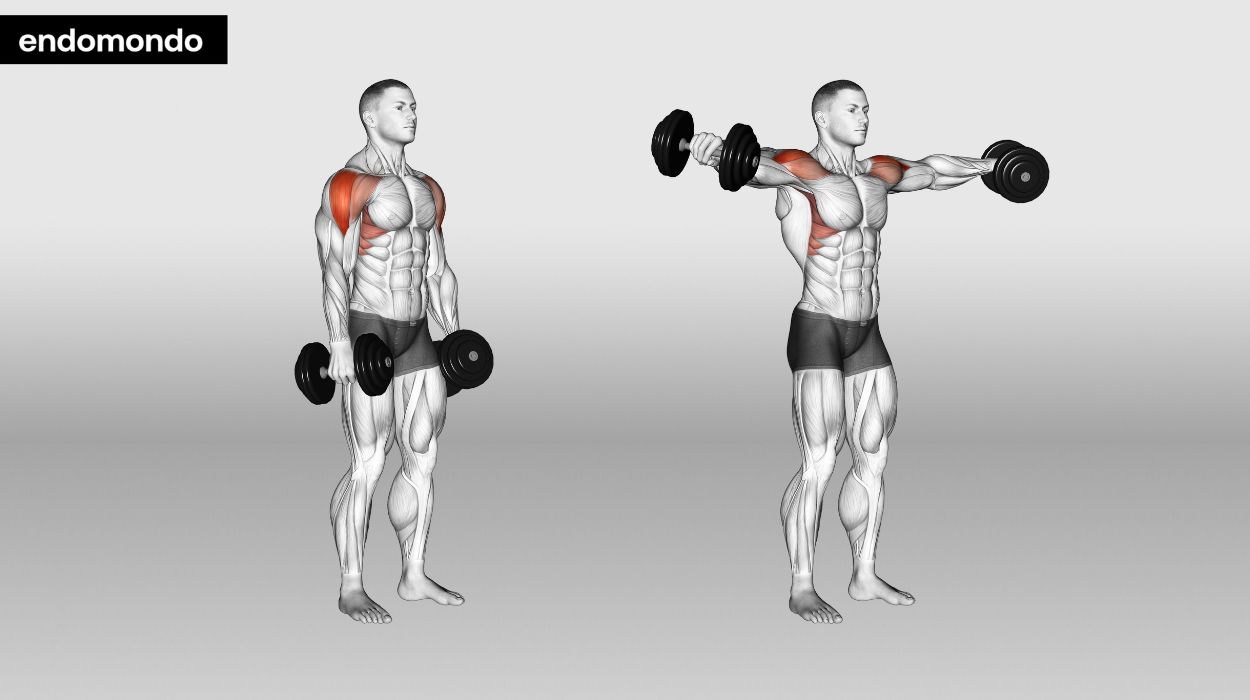
How to do:
- Begin by standing with your feet shoulder-width apart and with a straight posture. Dumbbells are at your side.
- The lateral raise is performed by keeping your arms extended as you raise them straight to the sides.
- Lift the dumbbells slightly above shoulder level and hold for a few seconds.
- Lower the dumbbells in a smooth, controlled fashion, stopping at about 30 degrees to your torso before repeating.
Tips:
- Perform this exercise early in your workout to emphasize building your lateral deltoid muscles.
- If you perform this exercise late in your workout, you are more likely to engage your entire shoulder.
- This exercise can also be performed from a seated position with an upright posture maintained.
- Keep the descent controlled and stop at a 30-degree angle to your torso before your next rep.
Optimal Sets & Reps: 3-4 sets of 8-12 reps.
Standing Alternating Dumbbell Front Raise
This exercise is similar to a lateral raise but focuses more on the anterior deltoid muscle. This allows you to focus on each shoulder independently for equal muscle growth. It also allows one side to rest while the other is working, so you may be able to perform more reps.
A lighter weight should be selected to promote proper isolation and reduce the risk of injury.
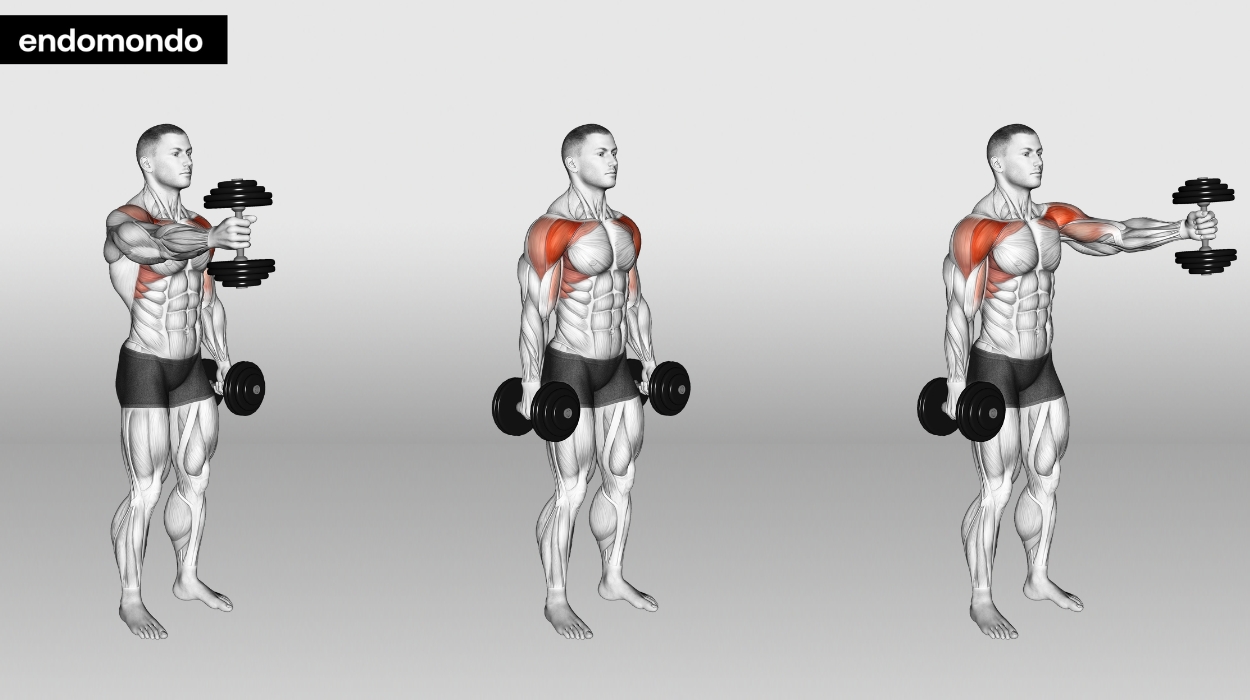
How to do:
- Start in a standing position with your back straight and the dumbbells in front of your thighs with your palms facing your thighs.
- Engage your core to ensure your torso is not contributing to your momentum.
- Lift your arm straight out in front of you. You may allow a slight bend in your elbow.
- Raise to a point where the dumbbell is slightly above shoulder level and hold for a moment.
- Lower the dumbbell back to the starting position in a slow, controlled fashion.
- Alternate between your right and left arms until each arm has performed the targeted number of reps.
Tips:
- Exhale as you lift and maintain the highest position.
- Inhale as you perform the controlled return to the starting position.
- Keep your core engaged to ensure shoulder muscle activation.
Optimal Sets & Reps: 3-4 sets of 8-12 reps.
Supine Kettlebell Arm Bar
Performing the arm bar exercise is about improving joint health and stability. This will help you keep your rotator cuff muscles engaged and stable, which will help you avoid injury during your shoulder workout routine.
How to do:
- Start by lying on your right side and grasping the handle of the kettlebell with your right hand.
- Maintain a tight grip using all of your fingers.
- Roll sideways onto your back, pushing the kettlebell upward.
- Hold this position for 10 to 45 seconds, ensuring your wrist remains in the neutral position.
- Repeat, alternating sides.
Tips:
- Variations that add a literal twist of your arm can be performed.
- This isn’t about maximizing weight. It is about keeping your arm as stable as possible, even as your body moves. This is what helps you build stability around the joint.
Optimal Sets & Reps: Hold the target position for 10 to 45 seconds, repeating 3-6 times.
Standing Cable Face Pulls
Performing a face pull will help you promote shoulder stability and engage your back. You engage the posterior deltoids and trapezius when pulling each shoulder blade together. Cable machines also offer many other helpful lat pulldown alternatives to target your back in different ways.
This cable shoulder workout can be performed with light weights and used as a warm-up before moving to more intense exercises.
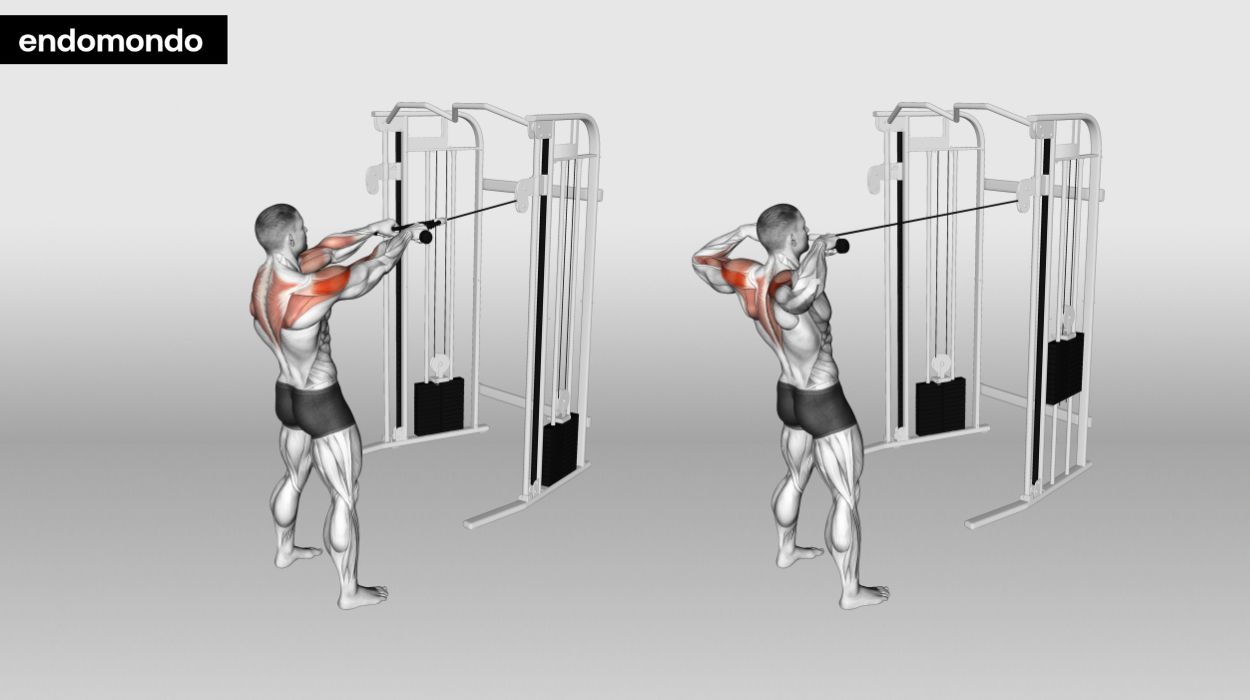
How to do:
- Begin by standing with your feet shoulder-width apart, facing the cable machine.
- Set the cable height to eye level.
- Grasping both ends of the rope connection, raise your arms to shoulder height.
- Keep your back straight and pull the center cable connection toward your face by pulling your arms apart and back.
- Hold this position momentarily before a controlled release back to the starting position.
Tips:
- Keep your elbows high and the rope at eye level.
- Keep your back and head in a stable position; pull the rope to yourself rather than allow yourself to lean.
- If you find yourself leaning, you can alter the stance by lowering the cable and taking one knee.
Optimal Sets & Reps: 3-4 sets of 10-15 reps.
45-Degree Chest-Supported Dumbbell Row
During many exercises, the back is needed to provide additional support for the shoulders and help with pulling the shoulders back. A chest-supported row can help with overall stability by strengthening the back while helping you target the posterior deltoids. This is a more stable position for your spine, so you should be able to increase the weight you pull if desired.
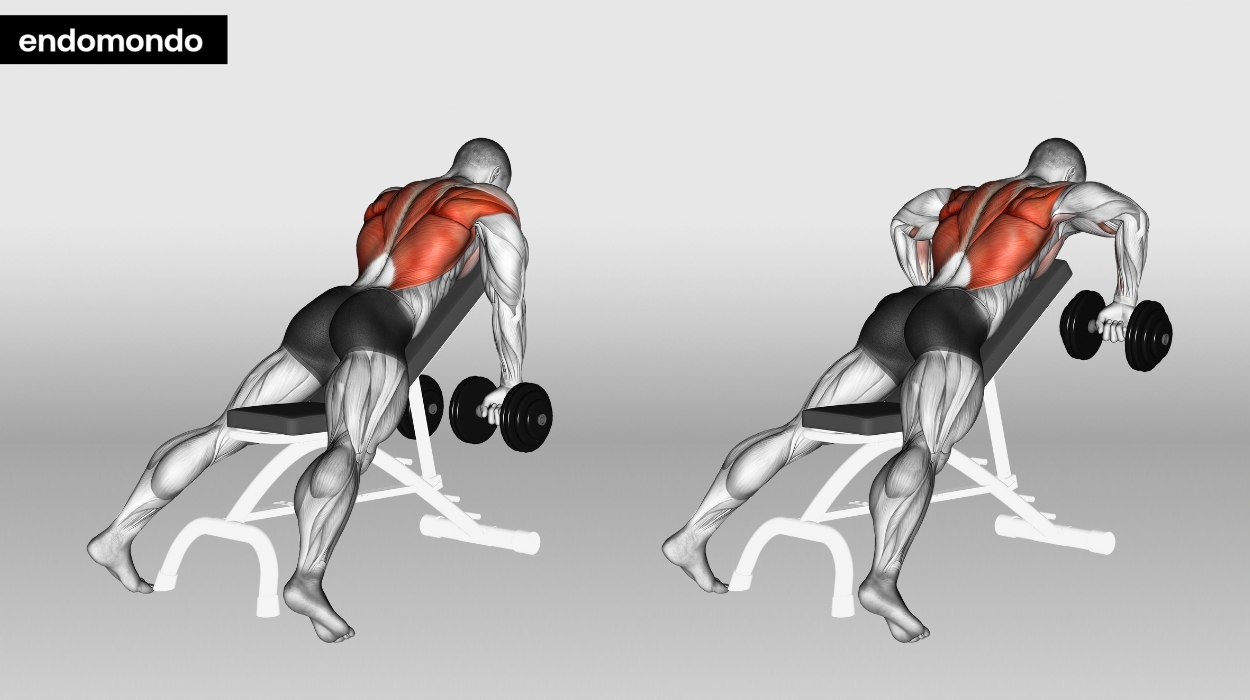
How to do:
- Set a workout bench to a 45-degree incline.
- Grasp your dumbbells and lie chest-down on the bench with your toes pressed into the floor. Hold the dumbbells with your palms facing inward.
- Engage your glutes and abs as you retract your shoulder blades and pull your elbows upward toward the ceiling. Your upper arm should be tight against your body.
- Pause for a moment at the highest point and then slowly lower the weights back down to the starting position in a controlled manner.
Tips:
- Press into the bench to create additional stability through your core. Keep your abs and glutes engaged throughout the exercise.
- Lowering the weights slowly and under control is crucial for building muscle.
- If you are building muscle mass, you may want to opt for four sets of ten reps. Select a weight that would allow you to do one or two more reps in each set to maintain proper form throughout the workout.
Optimal Sets & Reps: 3-4 sets of 8-12 reps.
Shoulder Muscles Anatomy
Many muscles play a role in the health and stabilization of the shoulder. These can be broken into two basic categories: intrinsic and extrinsic shoulder muscles. [3]
Intrinsic muscles are more closely associated with the shoulder and tend to connect the scapula or clavicle (upper torso) with your upper arm. Extrinsic muscles support the shoulder and tend to connect your torso with the bones near your shoulder joints.
These basic categories comprise several individual muscles that help with joint stability and perform specific movements.
Intrinsic Muscles
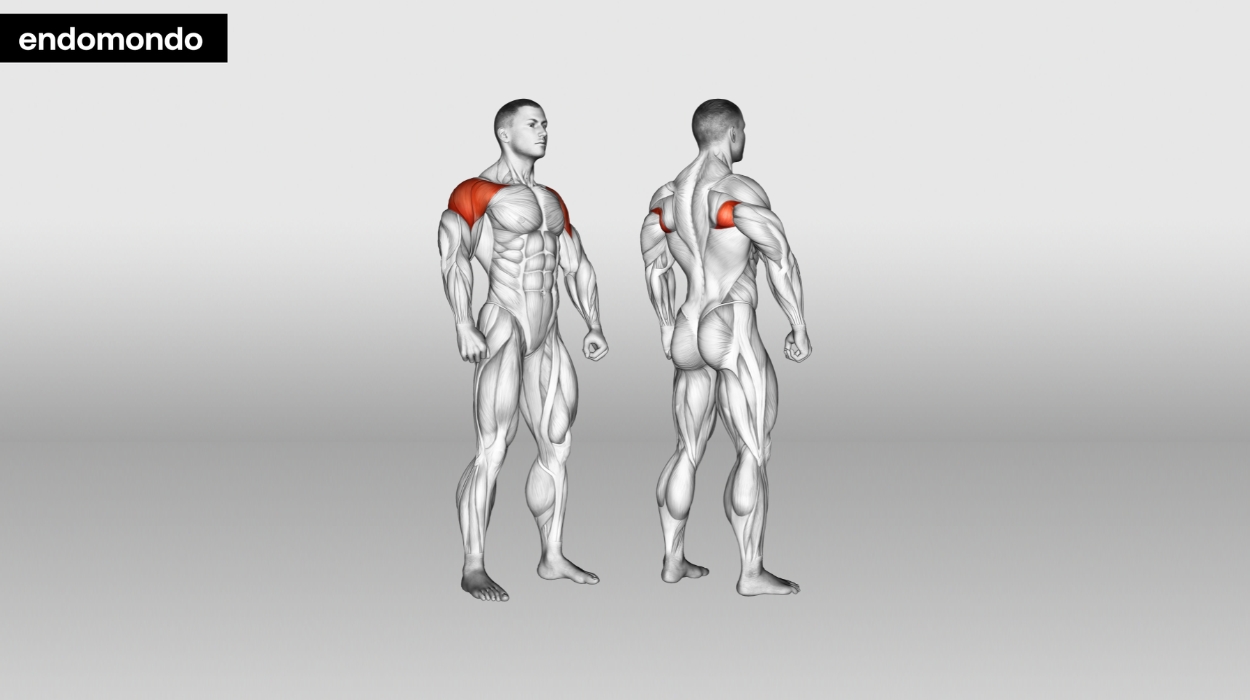
- Rotator cuff: These muscles and tendons surround the shoulder joint directly and support stability and mobility. This could be considered the core of the shoulder musculature, as these muscles are responsible for keeping your upper arm in place in the shoulder socket.
- Deltoid muscles: When you think about building defined, rounded, broad shoulders, these muscles become the most prominent. In addition to contributing to your upper body physique, these muscles help define shoulder mobility and stability.
The deltoids are broken down into three primary fibers. These are the posterior or rear, the lateral or middle, and the anterior or front.
- Teres Major: This is a small muscle that aids your lats with the extension and rotation of your arms. It runs from your shoulder joint to the back of your armpit.
Extrinsic Muscles
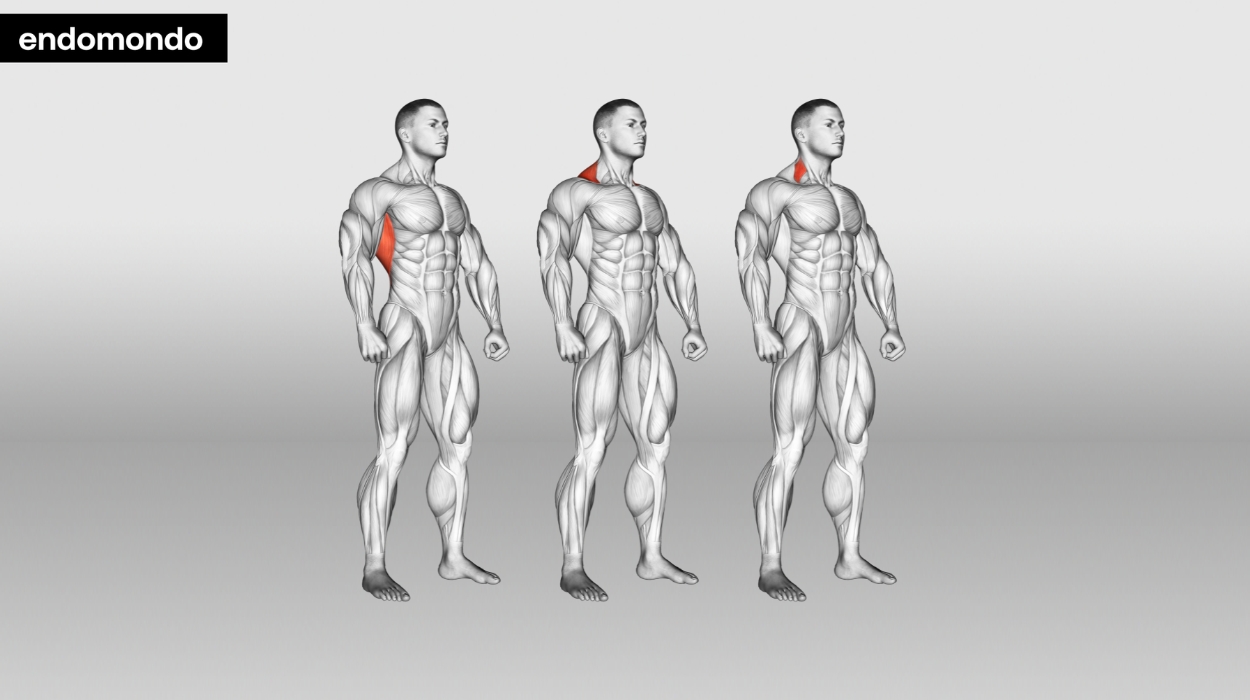
- Latissimus Dorsi: Often called the lat, this muscle is the most broad muscle of the back. It connects in the middle and lower back at the spine and your upper arm, helping to support the extension and rotation of your arms.
- Trapezius: This is the triangle-shaped muscle located in your neck and upper back. It runs from your spine across your shoulder blades to your shoulders and helps support shoulder and arm movement.
- Levator Scapulae: This muscle helps lift the scapula and move the neck. It helps stabilize the shoulder and spine.
- Rhomboids: Shaped like a rhombus, these muscles are located in the upper back. They help stabilize the spine and retract the scapula. This means they are activated when you pull your shoulders back.
Benefits Of Shoulder Workouts For Men
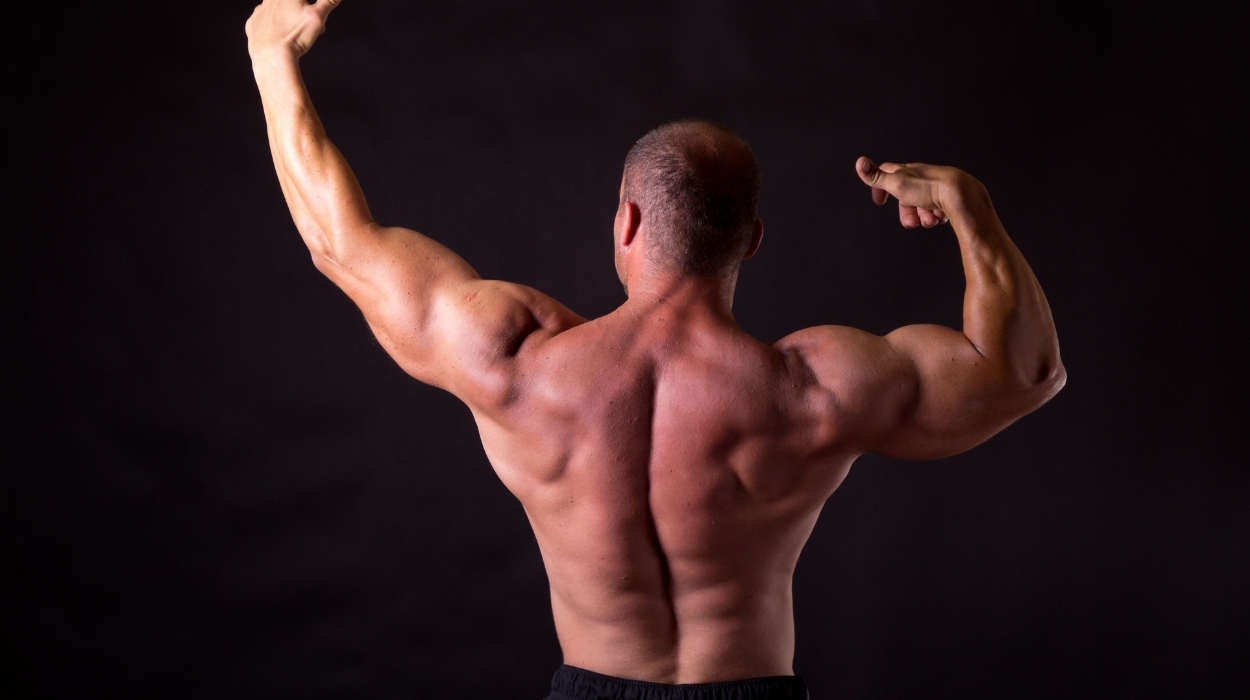
Shoulder exercises are often a dreaded part of a workout regimen but can pay dividends. Implementing these consistently can:
- Improve your posture.
- Help you bulk up and gain muscle definition.
- Improve joint stability and help you avoid injury, particularly if you include stretches and mobility exercises.[4]
- Lower your risk of cardiovascular disease [5] when included in a broader weight-training regimen.
Tips To Stay Safe And Increase Efficacy For Shoulder Exercises
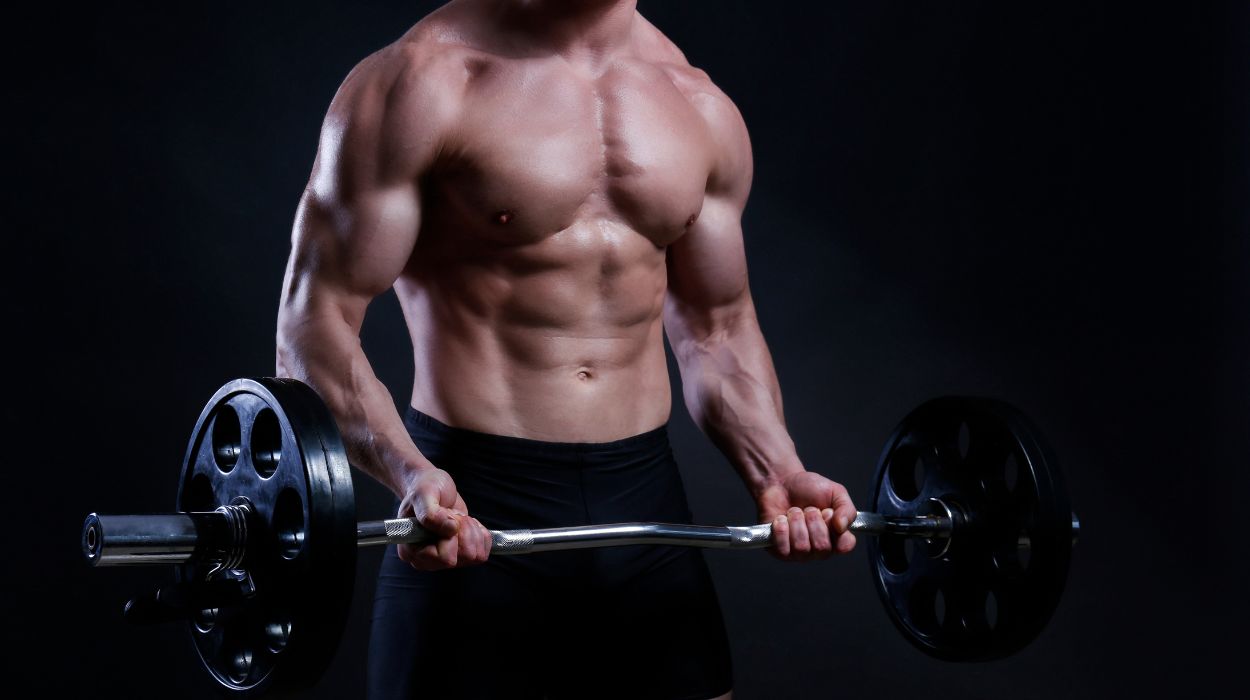
Staying safe and avoiding injury should always be at the top of your priorities when approaching your exercise routine. Some excellent baseline rules include:
- Warm up and stretch before beginning your workouts.
- If you are new to weight training exercises, consider consulting a registered trainer to help you perform the exercises with the appropriate form.
- Use a spotter, especially when increasing weights.
- Maintain your form. This is more important than adding weight quickly.
- Stay consistent with your routine over time.
The best way to stimulate increased muscle mass [6] is to perform three to 6 sets of 6 to 12 repetitions with 60 seconds of rest at moderate effort. Maintaining form is crucial for preventing injury and the appropriate isolation of targeted muscles to stimulate growth. Two days per week per muscle group is sufficient to see results.
Your diet is also crucial for producing results. A diet with plenty of lean proteins, whole grains, and low saturated fat will help you stay on track.
Conclusion
Incorporating shoulder training into your weight-lifting routine is important. With the proper approach, you can build muscle mass and definition all while improving stability and lowering your chance of injury.
Keep pushing yourself but be smart about it! Keep those muscles well-fed, warmed up, and stretched, and include exercises that focus on mobility as well as bulk.
Frequently Asked Questions
Different exercises can target different areas of the deltoids. By combining exercises that individually target the posterior, lateral, and anterior deltoids, you can engage all three groups.
There is no single exercise that is superior to alternatives. Learning a variety of exercises can help you keep your routine fresh and improve your engagement of all the associated muscles rather than focusing on one area.
Many people approach the shoulders as a part of an overall upper body workout by incorporating exercises for the arms and back.
It depends on your goals and current status, but four exercises should allow you to effectively target each delt area. It is also helpful to incorporate exercises more specifically designed to promote stability.
Yes, shoulder shrugs can target the trapezius, delts, and upper arms. This can help you produce muscle mass and strength and help with posture.
Individual exercises can vary, but when you are focused on building mass, you may benefit from an approach that targets four sets of 10 reps. Use a weight that allows you to perform the exercises without sacrificing form.
Resources
- Campos, Y.A.C., Vianna, J.M., Guimarães, M.P., Oliveira, J.L.D., Hernández-Mosqueira, C., da Silva, S.F. and Marchetti, P.H. (2020). Different Shoulder Exercises Affect the Activation of Deltoid Portions in Resistance-Trained Individuals. Journal of Human Kinetics, 75(1), pp.5–14. doi:https://doi.org/10.2478/hukin-2020-0033.
- McKean, M.R. and Burkett, B.J. (2015). Overhead shoulder press – In-front of the head or behind the head? Journal of Sport and Health Science, 4(3), pp.250–257. doi:https://doi.org/10.1016/j.jshs.2013.11.007.
- Dawson-Amoah, K. and Varacallo, M. (2021). Anatomy, Shoulder and Upper Limb, Hand Intrinsic Muscles. [online] PubMed. Available at: https://www.ncbi.nlm.nih.gov/books/NBK539810/.
- Liaghat, B., Pedersen, J.R., Husted, R.S., Pedersen, L.L., Thorborg, K. and Juhl, C.B. (2022). Diagnosis, prevention and treatment of common shoulder injuries in sport: grading the evidence – a statement paper commissioned by the Danish Society of Sports Physical Therapy (DSSF). British Journal of Sports Medicine, 57(7), p.bjsports-2022-105674. doi:https://doi.org/10.1136/bjsports-2022-105674.
- LIU, Y., LEE, D.-C., LI, Y., ZHU, W., ZHANG, R., SUI, X., LAVIE, C.J. and BLAIR, S.N. (2019). Associations of Resistance Exercise with Cardiovascular Disease Morbidity and Mortality. Medicine & Science in Sports & Exercise, 51(3), pp.499–508. doi:https://doi.org/10.1249/mss.0000000000001822.
- Krzysztofik, M., Wilk, M., Wojdała, G. and Gołaś, A. (2019). Maximizing Muscle Hypertrophy: A Systematic Review of Advanced Resistance Training Techniques and Methods. International journal of environmental research and public health, 16(24), p.E4897. doi:https://doi.org/10.3390/ijerph16244897.




